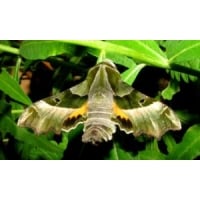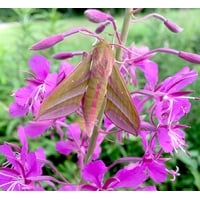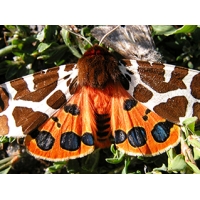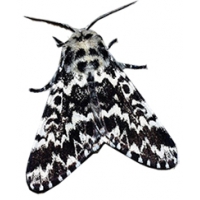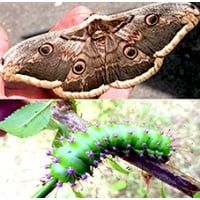MARKET STALL Everything a BARGAIN!
Small numbers only. First come first served!
Camberwell Beauty Nymphyalis antiopa
We cannot be sure of obtaining this species every year, and we are lucky to have them again!
Camberwell Beauty larvae feed on Sallow Salix caprea, Willows, Birch and some other trees. The larvae are gregarious nearly until pupation when they are most handsome with long branched spines and wonderful contrasting red blotches on the black ground colour.
In nature the pupae are suspended. In captivity it's wise to do the same. Please see advice on how to suspend pupae in the introduction to Exotic pupae. Keep the pupae moist, by misting with tepid water at least daily. Temperature of 20 deg C or a little more is ideal. Pupae usually hatch in a matter of days if conditions are right.
Privet Hawk Sphinx ligustri
SPECIAL OFFER 5 pupae £22.95 NOW £17.95 10 pupae £39.95 NOW £35.95 20 pupae £79.90 NOW £66.00
One of the largest Hawkmoths. Keep pupae cool for breeding next year.
The caterpillar becomes enormous and is characteristic of the name Sphinx moths, by its sphinx-like resting position. Adults emerge in June and July. They need nectar from the flowers of Privet, Valerian, Buddleia.
Larval foodplants: Privet, Lilac, Ash, also reportedly Spiraea, Viburnum opulus, and other Viburnums, Holly, Dogwood, Snowberry, Apple, Pear, Oleander, Leycesteria, Currant.
One generation in the year. Privet Hawks breed readily in a large cage with nectar and foodplant.
Willowherb Hawkmoth Proserpinus proserpina
SCARCE! Only a few pupae available.
This rather rare Hawkmoth is a gem, seldom encountered, though it lives throughout much of western and central Europe, eastwards into Russia.
The larva is rather like a grey form of Small Elephant Hawk. The foodplant is Rosebay Willowherb Epilobium, Evening Primrose Oenothera and Purple Loosetrife Lythrum. The pretty little green moth has prominent egg-yolk coloured hindwings. The normal flight period is June and July.
Elephant Hawk Dielephila elpenor
Store winter pupae refrigerated in a plastic box. In the emerging cage it is important to have the pupae moist but well drained. Please see the Pupae Nest on this website. The moths usually emerge in June and July.
Cage the moths with nectar flowers and springs of Willowherb – you do not see the pairings but fertile eggs are easily obtained.
An exceptionally pretty moth with amazing and characterful larvae, with eye-spots and probing “trunks”. Young larvae are green, later changing to charcoal black, with occasional rarities remaining green.
Larvae feed on Willowherbs, Fuschia, Creepers.
Highly recommended.
Garden Tiger Moth Arctia caja 50 larvae
The price for 50 Woolly Bears has been substantially reduced to encourage releasing in the wild.
Children love them!
Garden Tiger larvae Woolly Bears grow fast on Dock, Dandelion, Dead Nettle, Nettle and many other hedgerow plants, also Pussy Willow Salix caprea and Osier Willow Salix viminalis. You can also feed them conveniently on Cabbage.
Now a most difficult species to obtain.
These are spring and summer larvae. In the wild, late summer larvae would hibernate, but if you keep them warm and light, many will produce another generation this year.
If you wish to hibernate Wooly Bears, sleeve them in autumn on Willow or Sallow (Pussy Willow). The falling leaves curl to form a ventilated ball in which the larvae hibernate. If all goes well in winter the larvae emerge in spring and feed from the new spring leaves.
From October to spring the larvae are in hibernation. Orders are booked for dispatch when the larvae awake and feed.
Pine Arches Moth Panthea coenobita
Very seldom offered. A Noctuid that has characteristics akin to the Tussocks. The caterpillar is beautifully coloured and patterned with tufts and tussocks of hair, giving it excellent camouflage on the twigs of its foodplants which are Pines Pinus, Spruces Abies and Larches Larix.
Coenobita is relatively unknown and few breeders have raised it. The species is found over many parts of Europe (excluding Britain) Spain and most of France. Its range extends to the Far East.
Giant Peacock Moth Saturnia pyri
Magnificent - Europe’s largest moth. Flies in May, pairs easily and lays prodigiously. Exotic looking larvae.
Rear the larvae in warm, dry conditions. They are very easy to rear in the first instars and extra care is needed to bring them through the final instars. They repay proper care, growing fast and changing colour.
The large larva is as handsome as the tropical Saturniidae and has much in common with Moon Moth larvae, but with sapphire blue tubercles. They do well on Blackthorn and Plum and will often feed on other fruit trees and Hawthorn, Willows, Alder and Birch.



